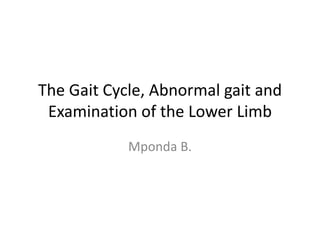
2.The Gait Cycle, Abnormal gait and Examination - Copy (2).pptx
- 1. The Gait Cycle, Abnormal gait and Examination of the Lower Limb Mponda B.
- 2. Gait • Gait simply means normal walking • Consists of 4 phases • Walking refers to the repetition of the 4 phases • 4 phases: 1) Heel-strike phase 2) Stance phase 3) Toes-off phase 4) Swing phase
- 4. • If there is a problem with gait, one must determine which phase is affected • Abnormal gait simply means limping • Limping has many causes • Patients who are brought on stretchers and wheelchairs, or come with the help of a walking aid (crutches, stick) indicate problems with gait
- 5. Abnormal Gait – Heel strike phase • Any pathology on the heel will affect the heel-strike phase and the heel will not touch the ground. • The problem may be congenital or acquired. • Patients will be walking on their toes. • Patients with congenital Tallipes Equino-varus deformity, have club feet and are unable to make the heel touch the ground • Patients with Congenital Equinus deformity present with horse feet and cannot walk properly. • An ulcer or any trauma to the heel also affects the heel-strike phase.
- 6. Abnormal Gait – Stance phase • Patients may present with shortening limp due to congenital shortening of one of the limbs. • Patients have a swinging gait • Must observe whether the shortening is in the femur or in the tibia and to what extent it is • Patients with pain in the joints of the lower limb i.e. Knee joint, hip joint or ankle joint present with Antalgic gait i.e. The stance phase is very short.
- 7. Abnormal Gait – Toes-off phase • Patients with Pathology on the base of the toes or the tarsal-metatarsal joint will not have the toes-off phase
- 8. Abnormal Gait – Swing phase • Patient with problems involving the abductors of the hip have an abnormal swing phase • Sciatic nerve palsy also causes abnormal swing phase • E.g. Patients with Palsy of the common Peroneal nerve is unable to dorsiflex the foot and presents with a High stepping gait. • Patients with problems of the abductors of the hip present with Trendelenburg gait (swinging on one side) and are Trendelenburg test positive.
- 9. • If both hips are affected, patients have a waddling gait.
- 10. Examination of the Lower Limb • The lower limb extends from the hip joint to the toe • Examination of a limb involves the examination of the bones and the joints of the limb. • Strip the patient to his underpants
- 11. • Observe how the patient walks to you • Examine for any obvious shortening of either of the limbs while the patient is standing. • Do the Trendelenburg test to check for any abnormalities involving the abductors of the hip joint • Ask the patient to stand on his/her toes to observe for any abnormalities
- 12. • Thereafter, ask the patient to lie on supine position • Inspection & palpation of the Musculoskeletal system • Inspection observe for any obvious deformities, and the axis of the lower limb. • Normal axes are 7-8º vulgus. • Abnormal axis – straight, knock knees, bow-legs, rickets. • Examine the feet • Check for any atrophy of the muscles of the thigh i.e. Compare the circumference of the muscles on both limbs.
- 13. • Measure the distance from the centre of the hip joint to the toe on both limbs i.e. From the anterior superior iliac spine to the medial malleolus. • Palpation tests • Palpate for any swellings, deformities and fractures. • Examination of the joints
- 14. Examination of the hip joint • Ball and socket joint of synovial variety • Articulation between the head of the femur and the acetabulum. • Stabilizing factors of the hip joint Ligamentum teres, extra capsular ligaments, ilio-femoral ligaments, ischio-femoral ligaments. • Blood supply: branches of the femoral artery
- 15. • Check if the Range of Movements (ROM) are normal i.e. Flexion, extension, abduction, adduction, internal rotation and external rotation. • F/E: 135 – 0 – 0 • IR/ER: 35 – 0 – 35 • ABD/ADD: 35 – 0 – 35
- 16. • Flexion contracture: 135-45-0 • Patient can flex normally but is unable to extend fully.
- 17. Examination of the Knee joint • Articulation between the femur and tibia – tibial-femoral joint • Stabilized by the medial and lateral collateral ligaments. • Anterior and posterior cruciate ligaments
- 18. Inspection • Is there a swelling? • Is the swelling uniform? • Is there any hypervascularization? • Is the skin normal? • Is there ulceration? • Is there atrophy of the muscles? • Is there effusion/fluid collection in the knee joint? How much?
- 19. • Fluctuation test / patella tap test – used to detect the amount of fluid in the knee joint. • Check the temperature of the knee joint for any inflammation. • Patella-grinding test – to check for the smoothness of the surface of the patella and any tenderness.
- 20. Range of movements • Knee joint is a hinge joint • F/E: 135-0-0 • Hyperextension: 135 – 0 – 5-10
- 21. Special tests for the Knee joint • Varus and Valgus stress tests for the lateral collateral and medial collateral ligaments respectively. • Lachmann test for the anterior and posterior cruciate ligaments. • Drawer’s test – test the movement of the tibia anteriorly and posteriory • Appley’s grinding/distraction test – Grinding test – for the meniscus – Distraction – for the ligaments
- 22. Examination of the Meniscus • Commonest – Mc Murray test • Rye’s test
Editor's Notes
- Trendelenburg test ask the patient to stand on one leg.
- * Mikulitz weight bearing axis
- Centre of the hip joint – mid-inguinal point